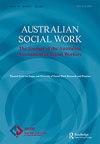A Modern History of Child Protection in Australia: Queensland 1965–1980
IF 2
3区 社会学
Q2 SOCIAL WORK
引用次数: 2
Abstract
ABSTRACT This article examines child protection policy and practice in Queensland in the 1960s and 1970s, which was a period of major social change affecting relations between children, families, and the state. Using government annual reports from the period, the article traces developments in policy and service delivery. It discusses changes in two interlinked areas: the use of preventative family support approaches and the expansion of the professional knowledge base. Understanding the history of a policy field can facilitate critical reflection on current debates. The child protection field continues to revisit long-standing tensions about the best ways to safeguard children from abuse and neglect in their families, albeit in different ways. IMPLICATIONS It is important to recognise and value the social work profession’s strong contribution to building the child protection knowledge base. Many current debates in child protection are not new: since the child protection field developed in the 1960s, it has continually revisited tensions about how best to intervene to address the individual and social causes of child abuse and neglect. Documenting the history of a social policy field can facilitate critical reflection on current developments.澳大利亚儿童保护的现代历史:1965-1980年的昆士兰州
本文考察了20世纪60年代和70年代昆士兰州的儿童保护政策和实践,这是一个影响儿童、家庭和国家关系的重大社会变革时期。本文利用这一时期的政府年度报告,追溯了政策和服务提供方面的发展。它讨论了两个相互关联领域的变化:使用预防性家庭支助办法和扩大专业知识库。了解一个政策领域的历史可以促进对当前辩论的批判性反思。儿童保护领域继续重新审视长期存在的紧张局势,即保护儿童免受家庭虐待和忽视的最佳方式,尽管方式不同。认识和重视社会工作专业在建立儿童保护知识库方面的巨大贡献是很重要的。目前关于儿童保护的许多争论并不新鲜:自从儿童保护领域在20世纪60年代发展以来,它不断地重新审视关于如何最好地干预以解决儿童虐待和忽视的个人和社会原因的紧张局势。记录一个社会政策领域的历史可以促进对当前发展的批判性反思。
本文章由计算机程序翻译,如有差异,请以英文原文为准。
求助全文
约1分钟内获得全文
求助全文
来源期刊

Australian Social Work
SOCIAL WORK-
CiteScore
4.20
自引率
16.70%
发文量
37
期刊介绍:
Australian Social Work is an international peer-reviewed journal reflecting current thinking and trends in Social Work. The Journal promotes the development of practice, policy and education, and publishes original research, theoretical papers and critical reviews that build on existing knowledge. The Journal also publishes reviews of relevant professional literature, commentary and analysis of social policies and encourages debate in the form of reader commentary on articles. Australian Social Work has grown out of the Australian context and continues to provide a vehicle for Australian and international authors. The Journal invites submission of papers from authors worldwide and all contributors are encouraged to present their work for an international readership.
 求助内容:
求助内容: 应助结果提醒方式:
应助结果提醒方式:


